Simultaneous Voltammetric Determination of Epinine and Venlafaxine Using Disposable Screen-Printed Graphite Electrode Modified by Bimetallic Ni-Co-Metal–Organic-Framework Nanosheets
Abstract
:1. Introduction
2. Results and Discussion
2.1. Determinations of NiCo-MOF Nanosheet Profiles
2.2. Electrochemical Activity of Epinine on the NiCo-MOF/SPGE
2.3. Analysis of Scan Rate Effect
2.4. Chronoamperometric Determinations
2.5. Standard Plot and Limit of Detection
2.6. Co-Detection of Epinine and Venlafaxine
2.7. Interference Study
2.8. The Repeatability, Reproducibility and Stability Analysis
2.9. Application of the Proposed Sensor for the Determination of Drugs in Real Samples
3. Experimental Section
3.1. Instruments and Reagents
3.2. Fabrication of Bimetallic NiCo-MOF Nanosheets
3.3. Fabrication of Screen-Printed Graphite Electrode Modified with NiCo-MOF
3.4. Preparation of Real Samples
3.4.1. Pharmaceutical Sample Solution Preparation
3.4.2. Preparation of Water Specimens
4. Conclusions
Author Contributions
Funding
Institutional Review Board Statement
Informed Consent Statement
Data Availability Statement
Conflicts of Interest
References
- Martínez-Mir, I.; Palop, V.; Morales-Olivas, F.J.; Estañ, L.; Rubio, E. The effects of epinine on arterial blood pressure and regional vascular resistances in anesthetized rats. Gen. Pharmacol. 1998, 31, 75–79. [Google Scholar] [CrossRef] [PubMed]
- Docci, D.; Pistocchi, E.; Turci, F.; Baldrati, L. Effect of ibopamine on the progression of chronic renal failure. Clin. Nephrol. 1986, 26, 121–124. [Google Scholar] [PubMed]
- Carpenter, J.F. An improved synthesis of 5, 6-diacetoxy-N-methylindole and of epinine. J. Org. Chem. 1993, 58, 1607–1609. [Google Scholar] [CrossRef]
- Tainter, M.L. Comparative actions of sympathomimetic compounds: Catechol derivatives. J. Pharmacol. Exp. Ther. 1930, 40, 43–64. [Google Scholar]
- Hua, C.; Lee, H.K.; Hsieh, A.K. Determination of epinine in human urine by high-performance liquid chromatography coupled with electrochemical detection using carbon fiber microelectrodes. Electroanalysis 1994, 6, 1147–1149. [Google Scholar] [CrossRef]
- Barger, G.; Dale, H.H. Chemical structure and sympathomimetic action of amines. J. Physiol. 1910, 41, 19. [Google Scholar] [CrossRef]
- Lima, J.L.; Loo, D.V.; Delerue-Matos, C.; da Silva, A.S.R. Electrochemical behaviour of Venlafaxine and its determination in pharmaceutical products using square wave voltammetry. Il Farm. 1999, 54, 145–148. [Google Scholar] [CrossRef]
- Madrakian, T.; Haryani, R.; Ahmadi, M.; Afkhami, A. A sensitive electrochemical sensor for rapid and selective determination of venlafaxine in biological fluids using carbon paste electrode modified with molecularly imprinted polymer-coated magnetite nanoparticles. J. Iran. Chem. Soc. 2016, 13, 243–251. [Google Scholar] [CrossRef]
- Toan, T.T.T.; Dao, A.Q.; Vasseghian, Y. A state-of-the-art review on the nanomaterial-based sensor for detection of venlafaxine. Chemosphere 2022, 297, 134116. [Google Scholar]
- Ding, L.; Li, L.; You, W.; Gao, Z.N.; Yang, T.L. Electrocatalytic oxidation of venlafaxine at a multiwall carbon nanotubes-ionic liquid gel modified glassy carbon electrode and its electrochemical determination. Croat. Chem. Acta 2015, 88, 81–87. [Google Scholar] [CrossRef]
- Ali, M.F.; El-Zahry, M.R. A comparative study of different electrodeposited NiCo2O4 microspheres anchored on a reduced graphene oxide platform: Electrochemical sensor for anti-depressant drug venlafaxine. RSC Adv. 2019, 9, 31609–31620. [Google Scholar] [CrossRef] [PubMed] [Green Version]
- Boomsma, F.; Alberts, G.; Van Der Hoorn, F.A.J.; in’t Veld, A.M.; Schalekamp, M.A.D.H. Simultaneous determination of free catecholamines and epinine and estimation of total epinine and dopamine in plasma and urine by high-performance liquid chromatography with fluorimetric detection. J. Chromatogr. B 1992, 574, 109–117. [Google Scholar] [CrossRef] [PubMed]
- Hicks, D.R.; Wolaniuk, D.; Russell, A.; Cavanaugh, N.; Kraml, M. A high-performance liquid chromatographic method for the simultaneous determination of venlafaxine and O-desmethylvenlafaxine in biological fluids. Ther. Drug Monit. 1994, 16, 100–107. [Google Scholar] [CrossRef] [PubMed]
- Raghubabu, K.; Swarup, L.S.; Kalyanaramu, B.; Rao, M.N.; Ramdas, C. Simple and inexpensive methods development for determination of venlafaxine hydrochloride from its solid dosage forms by visible spectrophotometry. E-J. Chem. 2012, 9, 1645–1654. [Google Scholar] [CrossRef]
- Wu, H.; Yuan, B.; Liu, Y.M. Chiral capillary electrophoresis–mass spectrometry of tetrahydroisoquinoline-derived neurotoxins: Observation of complex stereoisomerism. J. Chromatogr. A 2011, 1218, 3118–3123. [Google Scholar] [CrossRef] [Green Version]
- Rudaz, S.; Stella, C.; Balant-Gorgia, A.E.; Fanali, S.; Veuthey, J.L. Simultaneous stereoselective analysis of venlafaxine and O-desmethylvenlafaxine enantiomers in clinical samples by capillary electrophoresis using charged cyclodextrins. J. Pharma. Biomed. Anal. 2000, 23, 107–115. [Google Scholar] [CrossRef]
- Al Lawati, H.A.; Varma, G.B.; Suliman, F.E.O. High-throughput method for the analysis of venlafaxine in pharmaceutical formulations and biological fluids, using a tris (2, 2′-bipyridyl) ruthenium (II)–peroxydisulphate chemiluminescence system in a two-chip device. Luminescence 2013, 28, 44–49. [Google Scholar] [CrossRef]
- Mazloum-Ardakani, M.; Beitollahi, H.; Ganjipour, B.; Naeimi, H. Novel carbon nanotube paste electrode for simultaneous determination of norepinephrine, uric acid and d-penicillamine. Int. J. Electrochem. Sci 2010, 5, 531–546. [Google Scholar]
- Alavi-Tabari, S.A.; Khalilzadeh, M.A.; Karimi-Maleh, H. Simultaneous determination of doxorubicin and dasatinib as two breast anticancer drugs uses an amplified sensor with ionic liquid and ZnO nanoparticle. J. Electroanal. Chem. 2018, 811, 84–88. [Google Scholar] [CrossRef]
- Hosseini Fakhrabad, A.; Sanavi Khoshnood, R.; Abedi, M.R.; Ebrahimi, M. Fabrication a composite carbon paste electrodes (CPEs) modified with multi-wall carbon nano-tubes (MWCNTs/N, N-Bis (salicyliden)-1,3-propandiamine) for determination of lanthanum (III). Eurasian Chem. Commun. 2021, 3, 627–634. [Google Scholar]
- Joshi, P.; Mehtab, S.; Zaidi, M.G.H.; Tyagi, T.; Bisht, A. Development of polyindole/tungsten carbide nanocomposite-modified electrodes for electrochemical quantification of chlorpyrifos. J. Nanostruct. Chem. 2020, 10, 33–45. [Google Scholar] [CrossRef] [Green Version]
- Mohammadi, S.; Beitollahi, H.; Mohadesi, A. Electrochemical behaviour of a modified carbon nanotube paste electrode and its application for simultaneous determination of epinephrine, uric acid and folic acid. Sens. Lett. 2013, 11, 388–394. [Google Scholar] [CrossRef]
- Karimi-Maleh, H.; Karimi, F.; Orooji, Y.; Mansouri, G.; Razmjou, A.; Aygun, A.; Sen, F. A new nickel-based co-crystal complex electrocatalyst amplified by NiO dope Pt nanostructure hybrid; a highly sensitive approach for determination of cysteamine in the presence of serotonin. Sci. Rep. 2020, 10, 11699. [Google Scholar] [CrossRef] [PubMed]
- Shamsi, A.; Ahour, F. Electrochemical Sensing of Thioridazine in Human Serum Samples Using Modified Glassy Carbon Electrode. Adv. J. Chem. A 2021, 4, 22–31. [Google Scholar]
- John, A.; Benny, L.; Cherian, A.R.; Narahari, S.Y.; Varghese, A.; Hegde, G. Electrochemical sensors using conducting polymer/noble metal nanoparticle nanocomposites for the detection of various analytes: A review. J. Nanostruct. Chem. 2021, 11, 1–31. [Google Scholar] [CrossRef]
- Raoof, J.B.; Ojani, R.; Beitollahi, H.; Hosseinzadeh, R. Electrocatalytic oxidation and highly selective voltammetric determination of L-cysteine at the surface of a 1-[4-(ferrocenyl ethynyl) phenyl]-1-ethanone modified carbon paste electrode. Anal. Sci. 2006, 22, 1213–1220. [Google Scholar] [CrossRef] [Green Version]
- Mohanraj, J.; Durgalakshmi, D.; Rakkesh, R.A.; Balakumar, S.; Rajendran, S.; Karimi-Maleh, H. Facile synthesis of paper based graphene electrodes for point of care devices: A double stranded DNA (dsDNA) biosensor. J. Colloid Interface Sci. 2020, 566, 463–472. [Google Scholar] [CrossRef]
- Bijad, M.; Hojjati-Najafabadi, A.; Asari-Bami, H.; Habibzadeh, S.; Amini, I.; Fazeli, F. An overview of modified sensors with focus on electrochemical sensing of sulfite in food samples. Eurasian Chem. Commun. 2021, 3, 116–138. [Google Scholar]
- Lohrasbi-Nejad, A. Electrochemical strategies for detection of diazinon. J. Electrochem. Sci. Eng. 2022, 12, 1041–1059. [Google Scholar]
- Beitollahi, H.; Dourandish, Z.; Tajik, S.; Sharifi, F.; Jahani, P.M. Electrochemical Sensor Based on Ni-Co Layered Double Hydroxide Hollow Nanostructures for Ultrasensitive Detection of Sumatriptan and Naproxen. Biosensors 2022, 12, 872. [Google Scholar] [CrossRef]
- Ping, J.; Wu, J.; Wang, Y.; Ying, Y. Simultaneous determination of ascorbic acid, dopamine and uric acid using high-performance screen-printed graphene electrode. Biosens. Bioelectron. 2012, 34, 70–76. [Google Scholar] [CrossRef] [PubMed]
- Tajik, S.; Taher, M.A.; Beitollahi, H. First report for simultaneous determination of methyldopa and hydrochlorothiazide using a nanostructured based electrochemical sensor. J. Electroanal. Chem. 2013, 704, 137–144. [Google Scholar] [CrossRef]
- Stefano, J.S.; Montes, R.H.; Richter, E.M.; Muñoz, R.A. Flow-injection analysis with multiple-pulse amperometry for simultaneous determination of paracetamol and naproxen using a homemade flow cell for screen-printed electrodes. J. Braz. Chem. Soc. 2014, 25, 484–491. [Google Scholar] [CrossRef]
- Beitollahi, H.; Mohammadi, S.Z.; Safaei, M.; Tajik, S. Applications of electrochemical sensors and biosensors based on modified screen-printed electrodes: A review. Anal. Methods 2020, 12, 1547–1560. [Google Scholar] [CrossRef]
- Mustafa, Y.F.; Chehardoli, G.; Habibzadeh, S.; Arzehgar, Z. Electrochemical detection of sulfite in food samples. J. Electrochem. Sci. Eng. 2022, 12, 1061–1079. [Google Scholar] [CrossRef]
- Mohabis, R.M.; Fazeli, F.; Amini, I.; Azizkhani, V. An overview of recent advances in the detection of ascorbic acid by electrochemical techniques. J. Electrochem. Sci. Eng. 2022, 12, 1081–1098. [Google Scholar]
- Tajik, S.; Beitollahi, H.; Nejad, F.G.; Shoaie, I.S.; Khalilzadeh, M.A.; Asl, M.S.; Shokouhimehr, M. Recent developments in conducting polymers: Applications for electrochemistry. RSC Adv. 2020, 10, 37834–37856. [Google Scholar] [CrossRef]
- Saghiri, S.; Ebrahimi, M.; Bozorgmehr, M.R. NiO nanoparticle/1-hexyl-3-methylimidazolium hexafluorophosphate composite for amplification of epinephrine electrochemical sensor. Asian J. Nanosci. Mater. 2021, 4, 46–52. [Google Scholar]
- Hajializadeh, A. An electrochemical sensor for detection of vanillin in food samples using CuFe2O4 nanoparticles/ionic liquids modified carbon paste electrode. J. Electrochem. Sci. Eng. 2022, 12, 1193–1203. [Google Scholar] [CrossRef]
- Miraki, M.; Karimi-Maleh, H.; Taher, M.A.; Cheraghi, S.; Karimi, F.; Agarwal, S.; Gupta, V.K. Voltammetric amplified platform based on ionic liquid/NiO nanocomposite for determination of benserazide and levodopa. J. Mol. Liq. 2019, 278, 672–676. [Google Scholar] [CrossRef]
- Ardakani, M.M.; Taleat, Z.; Beitollahi, H.; Salavati-Niasari, M.; Mirjalili, B.B.F.; Taghavinia, N. Electrocatalytic oxidation and nanomolar determination of guanine at the surface of a molybdenum (VI) complex–TiO2 nanoparticle modified carbon paste electrode. J. Electroanal. Chem. 2008, 624, 73–78. [Google Scholar] [CrossRef]
- Peyman, H.; Roshanfekr, H.; Babakhanian, A.; Jafari, H. PVC Membrane Electrode Modified by Lawson as Synthetic Derivative Ionophore for Determination of Cadmium in Alloy and Wastewater. Chem. Methodol. 2021, 5, 446–453. [Google Scholar]
- Karimi-Maleh, H.; Darabi, R.; Shabani-Nooshabadi, M.; Baghayeri, M.; Karimi, F.; Rouhi, J.; Karaman, C. Determination of D&C Red 33 and Patent Blue V Azo dyes using an impressive electrochemical sensor based on carbon paste electrode modified with ZIF-8/g-C3N4/Co and ionic liquid in mouthwash and toothpaste as real samples. Food Chem. Toxicol. 2022, 162, 112907. [Google Scholar] [PubMed]
- Khan, Z.G.; Patil, M.R.; Nangare, S.N.; Patil, A.G.; Boddu, S.H.; Tade, R.S.; Patil, P.O. Surface nanoarchitectured metal–organic frameworks-based sensor for reduced glutathione sensing: A review. J. Nanostruct. Chem. 2022, 12, 1053–1074. [Google Scholar] [CrossRef]
- Tajik, S.; Beitollahi, H.; Nejad, F.G.; Kirlikovali, K.O.; Van Le, Q.; Jang, H.W.; Shokouhimehr, M. Recent electrochemical applications of metal–organic framework-based materials. Cryst. Growth Des. 2020, 20, 7034–7064. [Google Scholar] [CrossRef]
- Nabi Bidhendi, G.; Mehrdadi, N.; Firouzbakhsh, M. Removal of Lead from Wastewater by Iron–Benzenetricarboxylate Metal-Organic Frameworks. Chem. Methodol. 2021, 5, 271–284. [Google Scholar]
- Akeremale, O.K. Metal-Organic Frameworks (MOFs) as Adsorbents for Purification of Dye-Contaminated Wastewater: A Review. J. Chem. Rev. 2022, 4, 1–14. [Google Scholar]
- Rezvani Jalal, N.; Madrakian, T.; Afkhami, A.; Ahmadi, M. Ni/Co Bimetallic Metal–Organic Frameworks on Nitrogen-Doped Graphene Oxide Nanoribbons for Electrochemical Sensing of Doxorubicin. ACS Appl. Nano Mater. 2022, 5, 11045–11058. [Google Scholar] [CrossRef]
- Roostaee, M.; Beitollahi, H.; Sheikhshoaie, I. Simultaneous Determination of Dopamine and Uric Acid in Real Samples Using a Voltammetric Nanosensor Based on Co-MOF, Graphene Oxide, and 1-Methyl-3-butylimidazolium Bromide. Micromachines 2022, 13, 1834. [Google Scholar] [CrossRef]
- Zhou, P.; Lv, J.; Huang, X.; Lu, Y.; Wang, G. Strategies for enhancing the catalytic activity and electronic conductivity of MOFs-based electrocatalysts. Coord. Chem. Rev. 2023, 478, 214969. [Google Scholar] [CrossRef]
- Dong, Y.; Gai, S.; Zhang, J.; Fan, R.; Hu, B.; Wang, W.; Yang, Y. Metal-organic frameworks with mixed-ligands strategy as heterogeneous nucleation center to assist crystallization for efficient and stable perovskite solar cells. J. Energy Chem. 2023, 77, 80–118. [Google Scholar] [CrossRef]
- Lv, J.; Liu, P.; Yang, F.; Xing, L.; Wang, D.; Chen, X.; Wang, G. 3D hydrangea macrophylla-like nickel–vanadium metal–organic frameworks formed by self-assembly of ultrathin 2D nanosheets for overall water splitting. ACS Appl. Mater. Interfaces 2020, 12, 48495–48510. [Google Scholar] [CrossRef] [PubMed]
- Wang, X.; Liu, B.; Li, J.; Zhai, Y.; Liu, H.; Li, L.; Wen, H. Conductive 2D Metal-organic Framework (Co, NiCo, Ni) Nanosheets for Enhanced Non-enzymatic Detection of Urea. Electroanalysis 2021, 33, 1484–1490. [Google Scholar] [CrossRef]
- Ezzati, M.; Shahrokhian, S.; Hosseini, H. In situ two-step preparation of 3D NiCo-BTC MOFs on a glassy carbon electrode and a graphitic screen printed electrode as nonenzymatic glucose-sensing platforms. ACS Sustain. Chem. Eng. 2020, 8, 14340–14352. [Google Scholar] [CrossRef]
- Sun, J.; Yu, X.; Zhao, S.; Chen, H.; Tao, K.; Han, L. Solvent-Controlled Morphology of Amino-Functionalized Bimetal Metal–Organic Frameworks for Asymmetric Supercapacitors. Inorg. Chem. 2020, 59, 11385–11395. [Google Scholar] [CrossRef]
- Zhang, X.; Chang, L.; Yang, Z.; Shi, Y.; Long, C.; Han, J.; Tang, Z. Facile synthesis of ultrathin metal-organic framework nanosheets for Lewis acid catalysis. Nano Res. 2019, 12, 437–440. [Google Scholar] [CrossRef]
- Palanisamy, S.; Wu, H.M.; Lee, L.Y.; Yuan, S.S.F.; Wang, Y.M. Fabrication of 3D Amino-Functionalized Metal–Organic Framework on Porous Nickel Foam Skeleton to Combinate Follicle Stimulating Hormone Antibody for Specific Recognition of Follicle-Stimulating Hormone. JACS Au 2021, 1, 2249–2260. [Google Scholar] [CrossRef]
- Wen, P.; Gong, P.; Sun, J.; Wang, J.; Yang, S. Design and synthesis of Ni-MOF/CNT composites and rGO/carbon nitride composites for an asymmetric supercapacitor with high energy and power density. J. Mater. Chem. A 2015, 3, 13874–13883. [Google Scholar] [CrossRef]
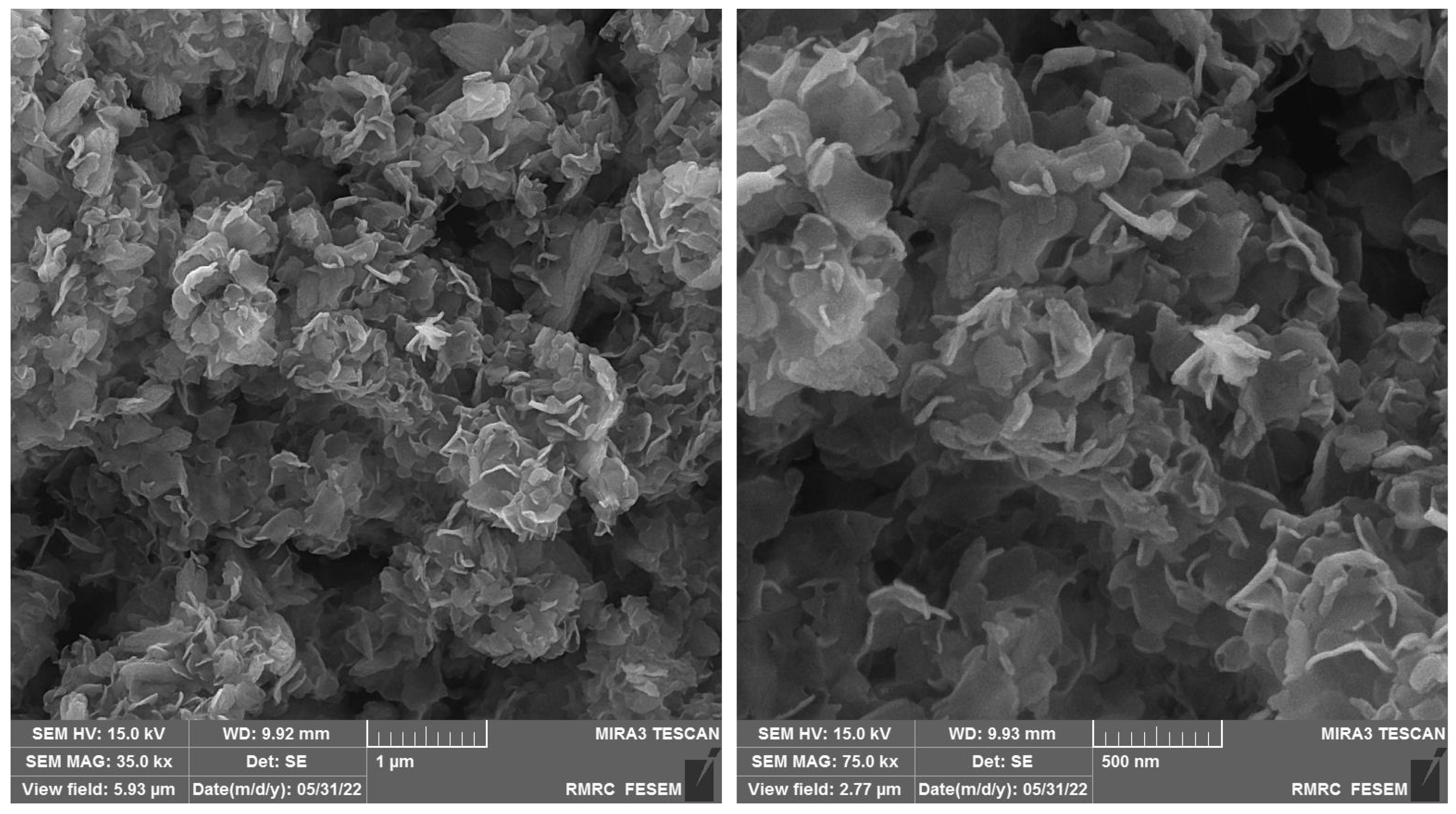
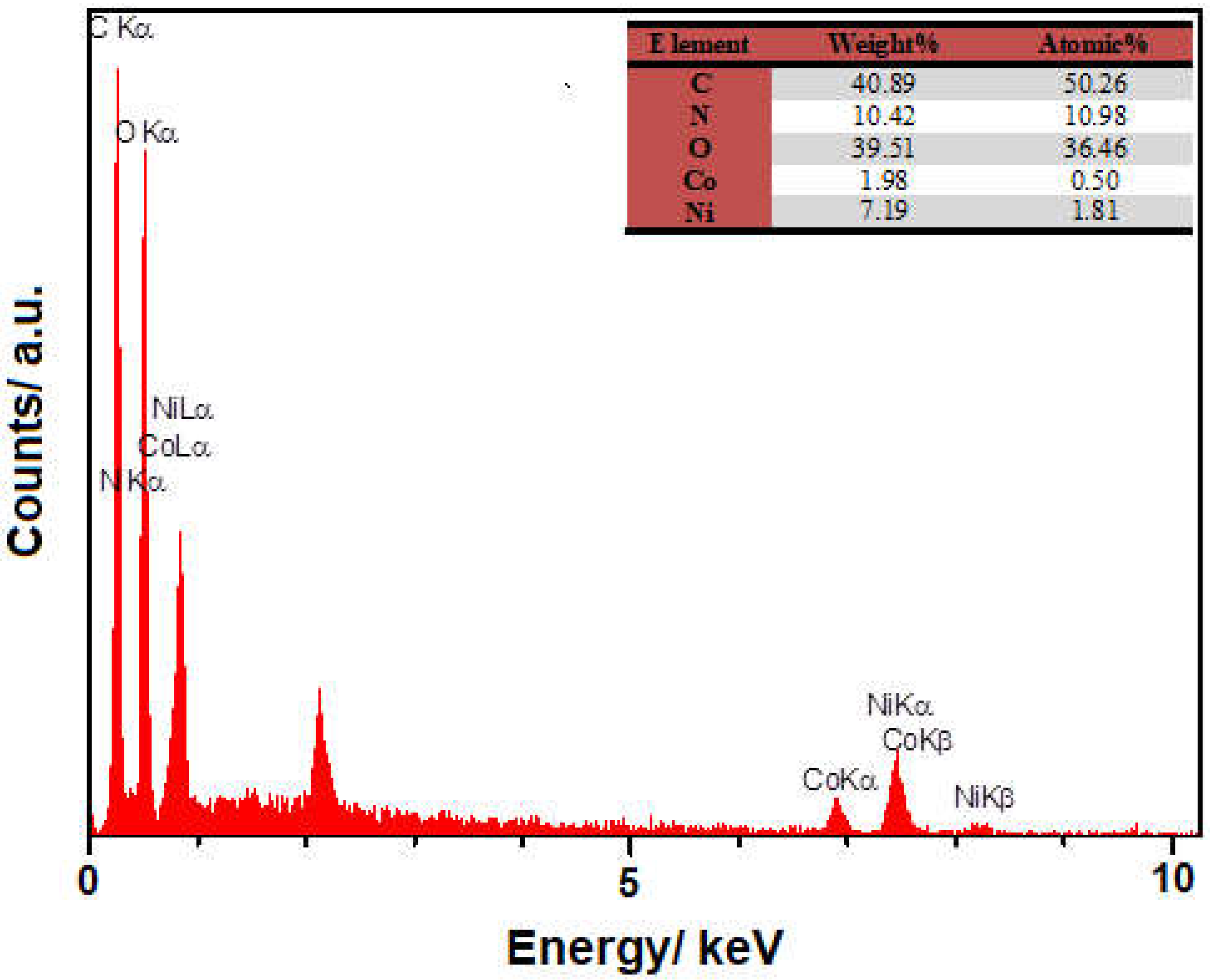
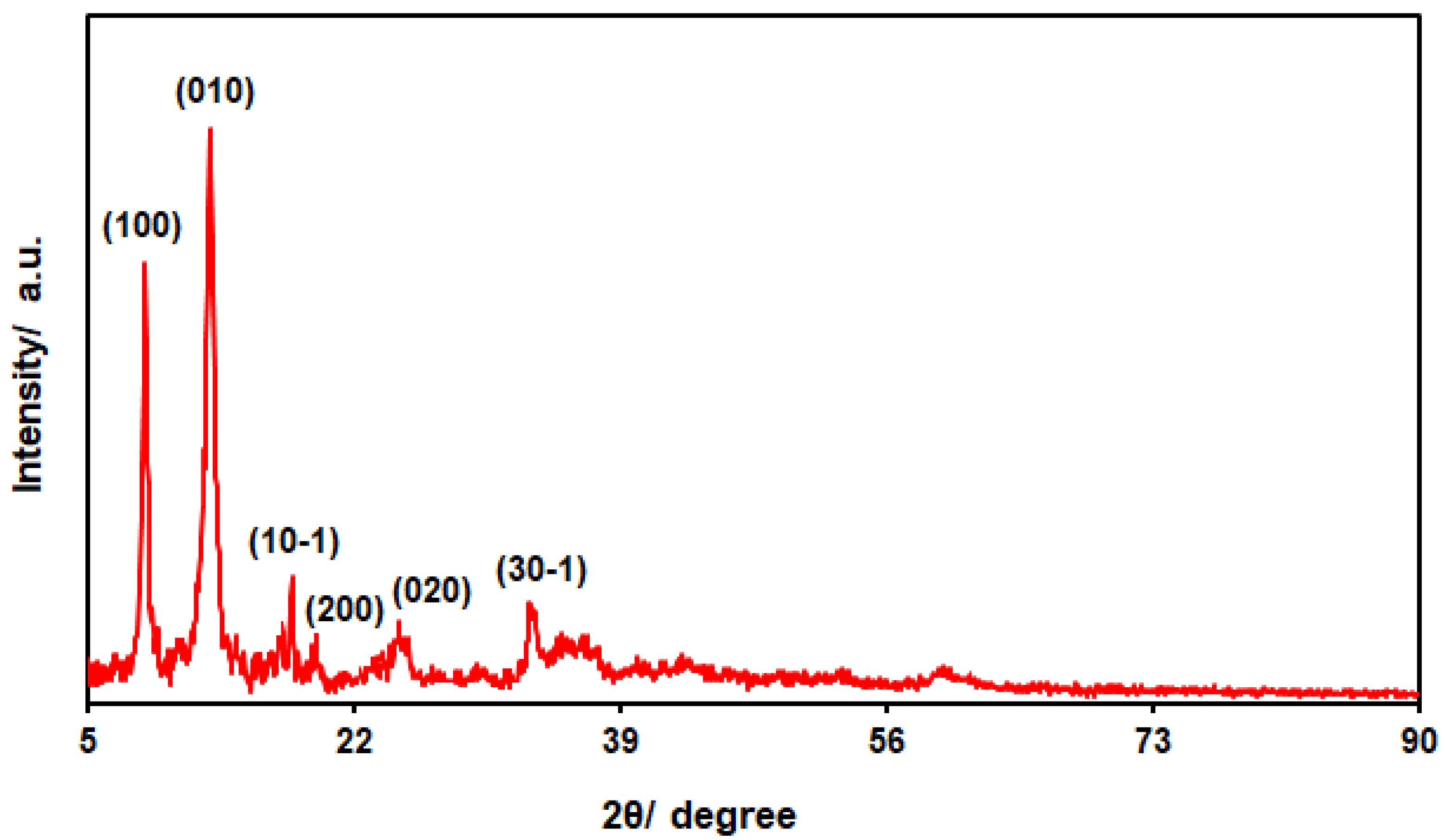
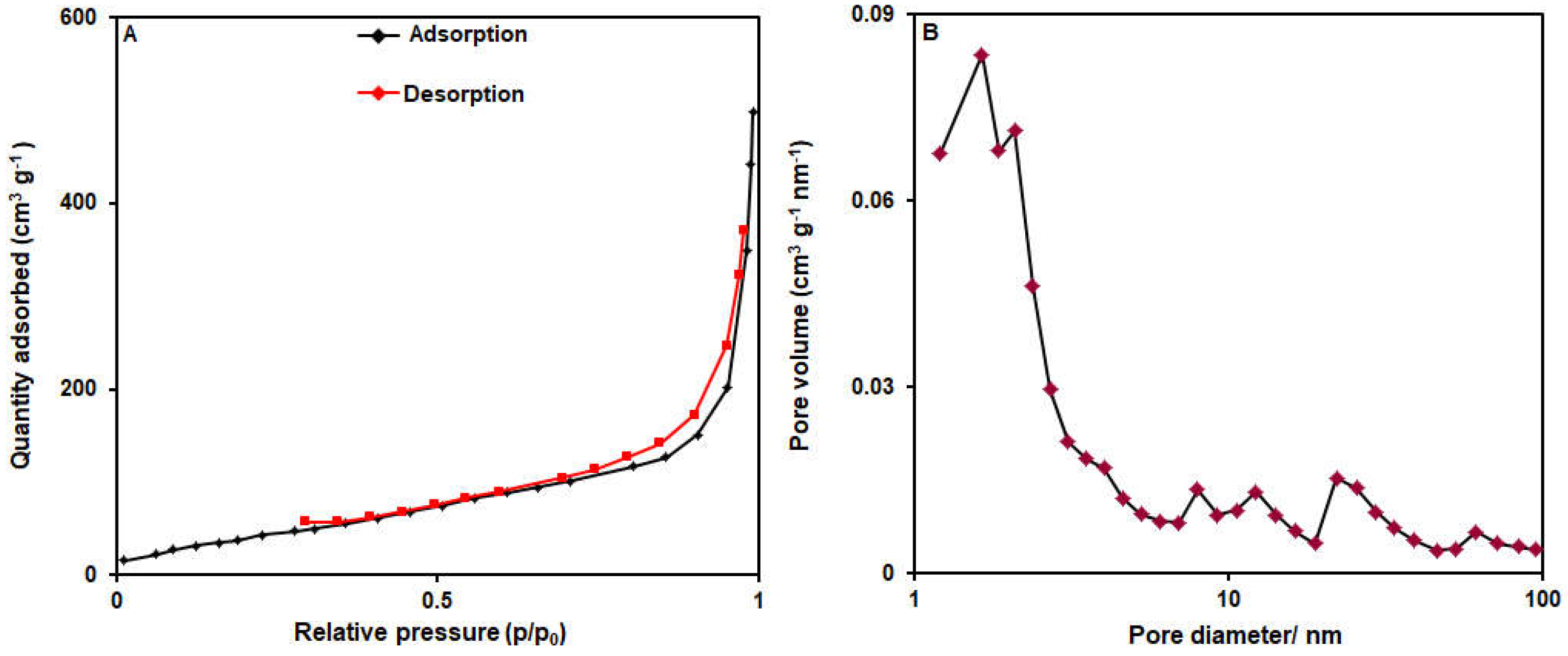

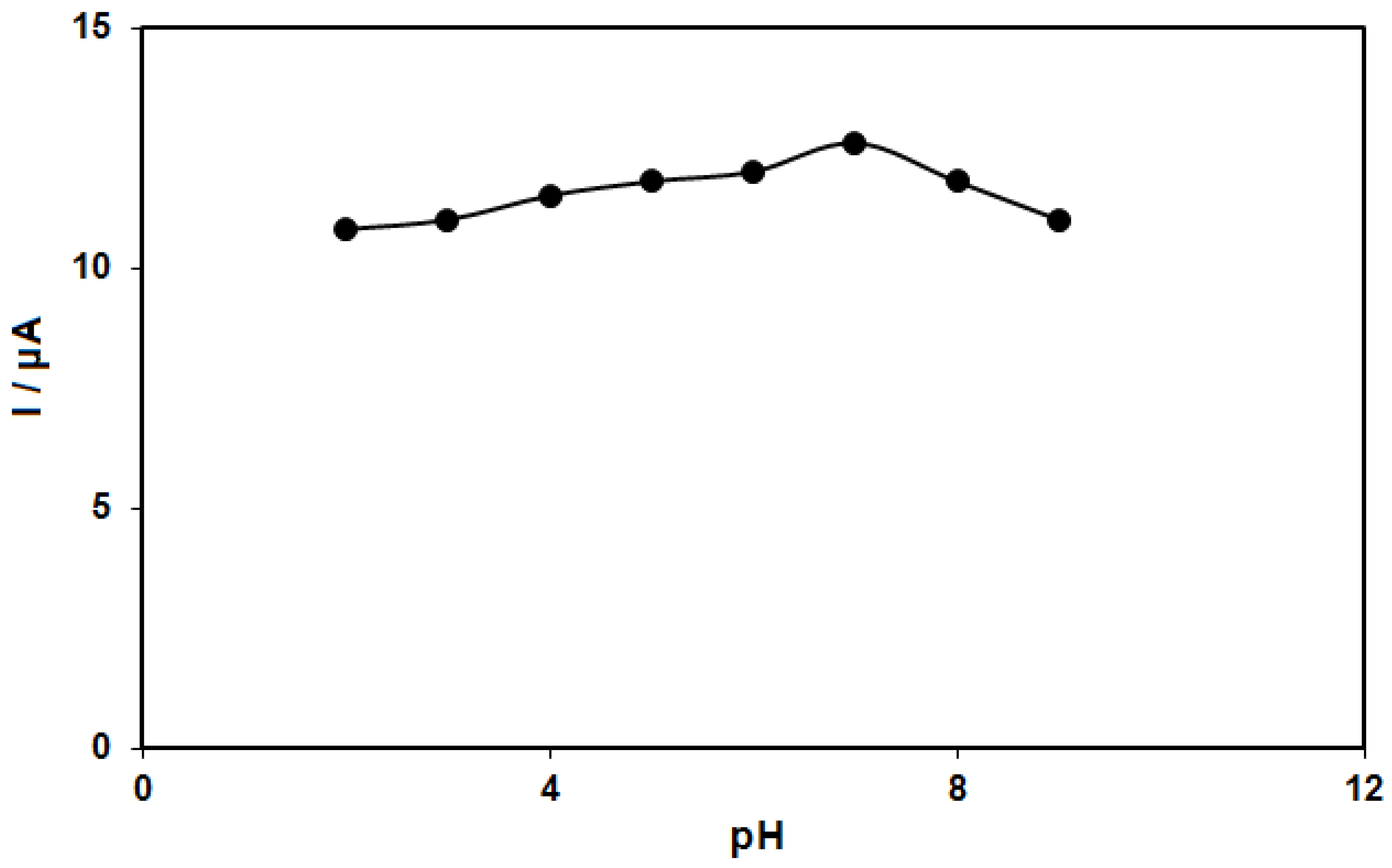

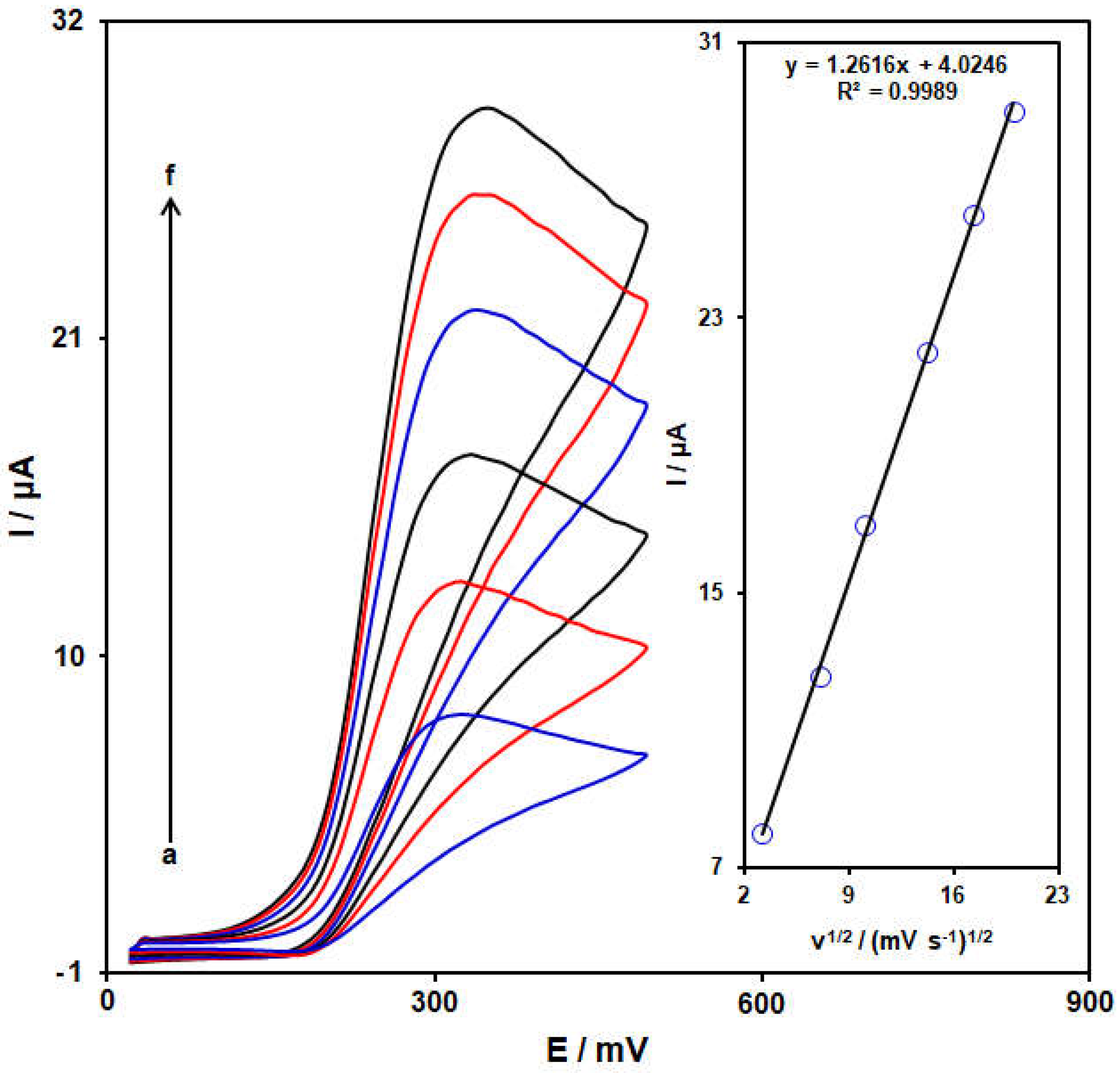
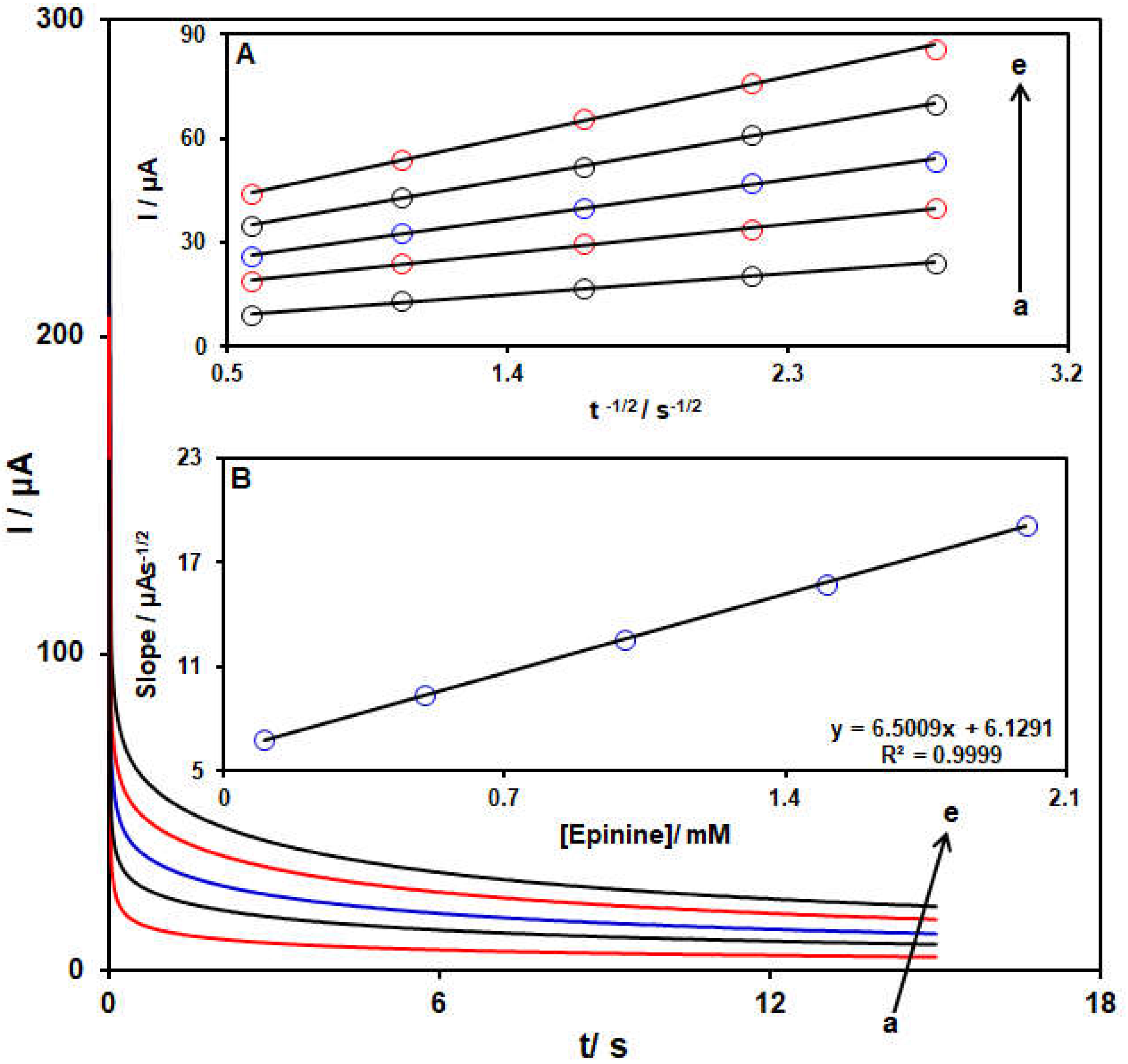
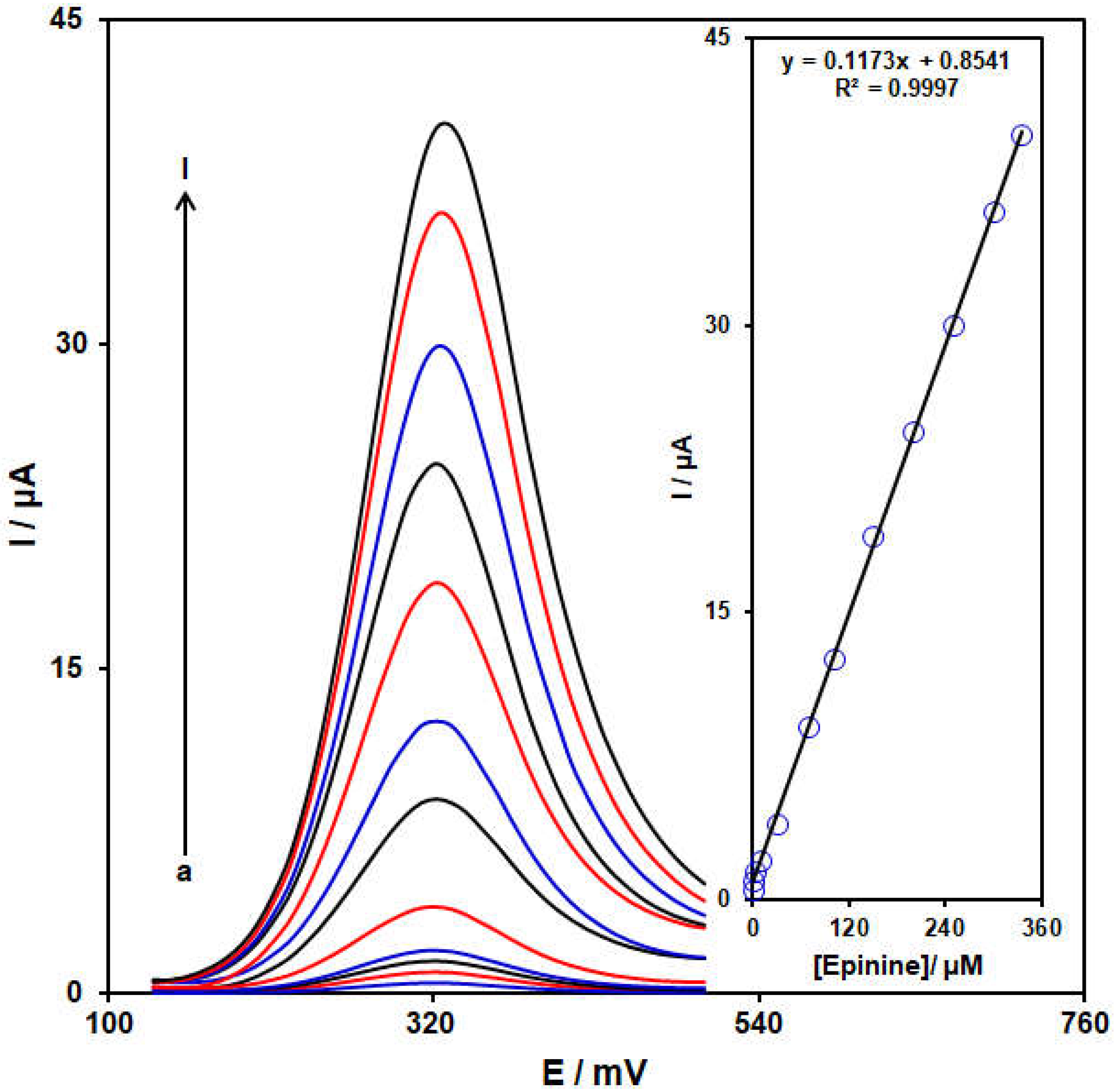
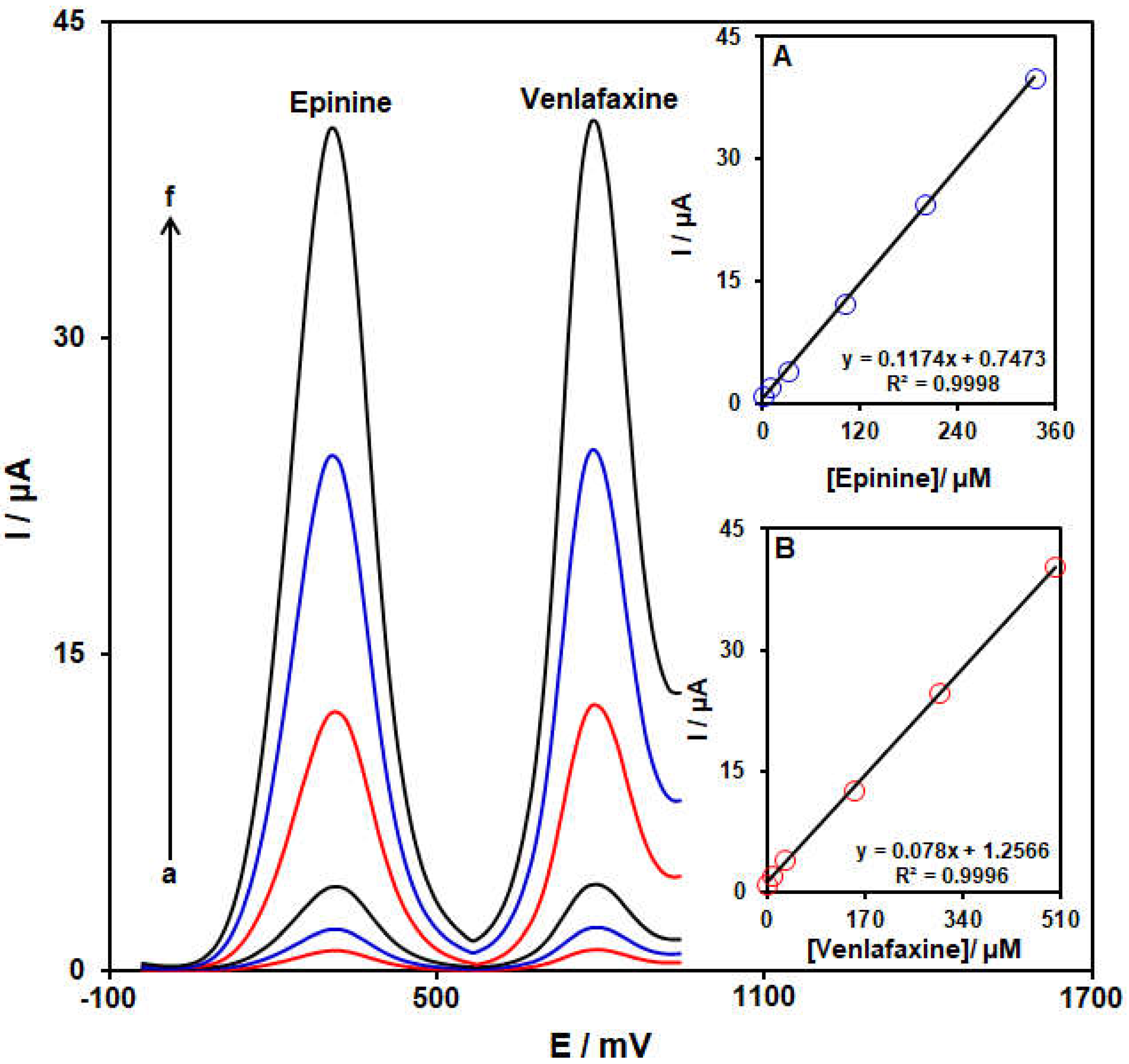
| Sample | Spiked | Found | Recovery (%) | R.S.D. (%) | ||||
|---|---|---|---|---|---|---|---|---|
| Epinine | Venlafaxine | Epinine | Venlafaxine | Epinine | Venlafaxine | Epinine | Venlafaxine | |
| Venlafaxine tablet | 0 | 0 | 3.2 | 3.0 | ||||
| 4.0 | 1.0 | 4.1 | 4.1 | 102.5 | 97.6 | 1.9 | 2.4 | |
| 5.0 | 2.0 | 4.9 | 5.3 | 98.0 | 101.9 | 3.2 | 1.8 | |
| 6.0 | 3.0 | 6.2 | 6.0 | 103.3 | 96.8 | 2.6 | 2.7 | |
| 7.0 | 4.0 | 6.9 | 7.4 | 98.6 | 102.8 | 2.3 | 2.9 | |
| Urine | 0 | 0 | ||||||
| 5.0 | 5.5 | 4.9 | 5.7 | 98.0 | 103.6 | 2.8 | 2.4 | |
| 7.0 | 7.5 | 7.1 | 7.3 | 101.4 | 97.3 | 1.9 | 3.5 | |
| 9.0 | 9.5 | 8.8 | 9.6 | 97.8 | 101.0 | 3.2 | 2.1 | |
| 11.0 | 11.5 | 11.5 | 11.4 | 104.5 | 99.1 | 2.7 | 1.7 | |
| Tap water | 0 | 0 | ||||||
| 4.0 | 4.5 | 3.9 | 4.7 | 97.5 | 104.4 | 1.8 | 3.5 | |
| 6.0 | 6.5 | 6.1 | 6.4 | 101.7 | 98.5 | 2.9 | 2.8 | |
| 8.0 | 8.5 | 7.9 | 8.6 | 98.7 | 101.2 | 3.0 | 1.6 | |
| 10.0 | 10.5 | 10.4 | 10.3 | 104.0 | 98.1 | 2.2 | 2.4 | |
Disclaimer/Publisher’s Note: The statements, opinions and data contained in all publications are solely those of the individual author(s) and contributor(s) and not of MDPI and/or the editor(s). MDPI and/or the editor(s) disclaim responsibility for any injury to people or property resulting from any ideas, methods, instructions or products referred to in the content. |
© 2023 by the authors. Licensee MDPI, Basel, Switzerland. This article is an open access article distributed under the terms and conditions of the Creative Commons Attribution (CC BY) license (https://creativecommons.org/licenses/by/4.0/).
Share and Cite
Dourandish, Z.; Beitollahi, H.; Sheikhshoaie, I. Simultaneous Voltammetric Determination of Epinine and Venlafaxine Using Disposable Screen-Printed Graphite Electrode Modified by Bimetallic Ni-Co-Metal–Organic-Framework Nanosheets. Molecules 2023, 28, 2128. https://doi.org/10.3390/molecules28052128
Dourandish Z, Beitollahi H, Sheikhshoaie I. Simultaneous Voltammetric Determination of Epinine and Venlafaxine Using Disposable Screen-Printed Graphite Electrode Modified by Bimetallic Ni-Co-Metal–Organic-Framework Nanosheets. Molecules. 2023; 28(5):2128. https://doi.org/10.3390/molecules28052128
Chicago/Turabian StyleDourandish, Zahra, Hadi Beitollahi, and Iran Sheikhshoaie. 2023. "Simultaneous Voltammetric Determination of Epinine and Venlafaxine Using Disposable Screen-Printed Graphite Electrode Modified by Bimetallic Ni-Co-Metal–Organic-Framework Nanosheets" Molecules 28, no. 5: 2128. https://doi.org/10.3390/molecules28052128





